The Bon dance is one of the Bon events. The dance is said to have started when people danced in delight along to the Buddhist chants because it rained after doing a ritual for rain. Bon dances were originally held to send off the spirits of our ancestors, but they have become local festivals for entertainment. Originally, Bon dance took place from early evening until dawn. People used to gather and dance spontaneously to welcome the spirits of the dead or deities in the early evening and to send off them at dawn. People danced on the border between this world and the netherworld. After send-off ceremony, people never look back, or the spirits come along. The original form of Bon dance is inherited in some areas.
Three main Bon odori(Bon dance) of Japan are Awa Odori(阿波踊り) in Tokushima Prefecture, Gujo Odori(郡上踊り) in Gifu Prefecture, and Nishimonai no Bon Odori(西馬音内の盆踊り) in Akita Prefecture.
Some information on Awa-odori(Awa dance festival) available at the following post:
Unfortunately, this year's Awa odori was a poorly run festival. Visitors and dancers were frustrated. Awa Odori Promotion Association announced that Awa odori will take place at a hall in Tokushima City as a charity event for the victims of the 2018 Japan floods on 24 September. Then about 1,000 dancers will perform at a park near the hall to raise money for the victims. Heavy downpours caused devastation across large parts of western Japan in late June through mid-July. The disaster left 225 dead and 11 missing (as of August 6.)
We've had many typhoons this year. In late July through early August, Typhoon Jongdari exceptionally moved from east to west over Japan, did two loops, and made landfall in Shanghai, China. Typhoon Soulik hit the Amami Islands, moved over the seas west of Kyushu, and made landfall in the Korean Peninsula on Friday before dawn. Typhoon Cimaron moved across the Japanese archipelago and weakened to a tropical storm on Friday. The remnants of typhoons Soulik and Cimaron brought heavy rainfall to Hokkaido.
For those who say Tokushima is far away, I tell them Awa-odori is seen in Tokyo and Saitama prefectures.
The 62nd Tokyo Koen-ji Awa Odori in Koen-ji, Tokyo
dates: 25 and 26 August
venues: Koen-ji Station, shopping mall around the station, and eight venues
A lot of dancing groups called ren dance at the venues and in the street. In 2017, 169 groups including ones in another areas, dancers from Tokushima participated in the dance festival.
Tokyo Koen-ji Awa Odori:
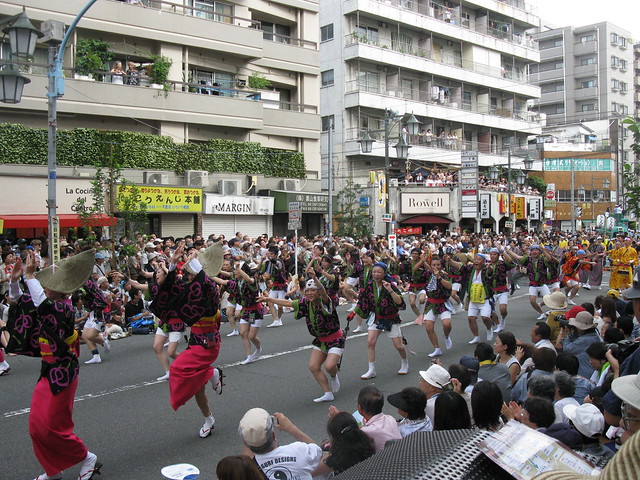 |
| Dancers 7 (credit:MarkPeteSwin/flickr) |
 |
| 120825高円寺阿波踊り21 (credit: midorisyu/flickr) |
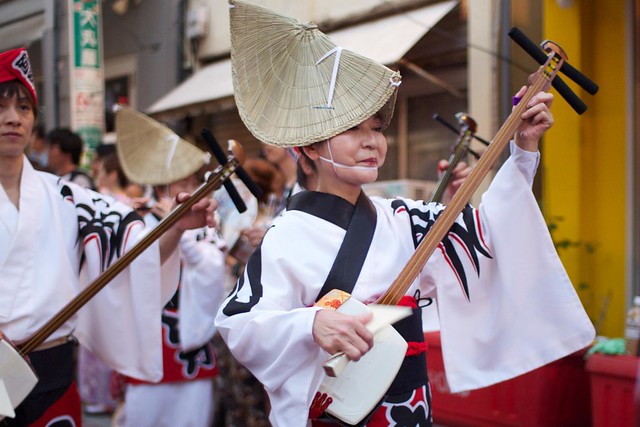 |
| 120825高円寺阿波踊り05 (credit: midorisyu/flickr) |
Minamikoshigaya Awa Dance in Koshigaya City, Saitama Prefecture
dates: 24 - 26 August
venues: Koshigaya Community Center(two halls and square), station square of Minamikoshigaya Station, and four venues(streets)
About 700,000 visitors came to watch this dance festival.
Minamikoshigaya Awa Dance:
https://www.saitamatsuri.jp/matsuri/koshigaya_awaodori/
http://www.minamikoshigaya-awaodori.jp/index.html (Japanese version only)
dates: 24 - 26 August
venues: Koshigaya Community Center(two halls and square), station square of Minamikoshigaya Station, and four venues(streets)
About 700,000 visitors came to watch this dance festival.
Minamikoshigaya Awa Dance:
https://www.saitamatsuri.jp/matsuri/koshigaya_awaodori/
http://www.minamikoshigaya-awaodori.jp/index.html (Japanese version only)
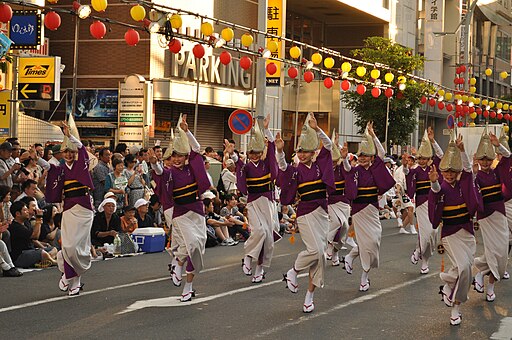 |
| credit:Ocdp from wikimedia commons |
Gujo Odori in Gujo Hachiman, Gifu Prefecture
The dance is taking place for 32 nights during a long period from July 14 to Semtember 8 this year. Dance venues are different each time. People dance in the streets from 8 p.m. until the next morning at 5 a.m.(4 a.m. on the last day) from 13 to 16 August. It has been designated an Important Intangible Folk Cultural Property.
Dancers have dancing geta(wooden clogs) for Gujo Odori. The event has 10 dance songs. The first song is "kawasaki", and the nine songs including kawasaki are played over and over again. The last song is "Matsusaka." It is played only once a day. I performed Bon dance to tunes of kawasaki in gym class during high school.
According to a historical paper published in 1840, shrine parishioners danced at their shrine until dawn during the Bon period until the middle of the 18th century. The Gujo Domain issued some proclamations that samurai, their family members and their servants were not to be allowed to go dancing during the Bon period.
Gujo Hachiman Tourism Association:
http://www.gujohachiman.com/kanko/odori_e.html
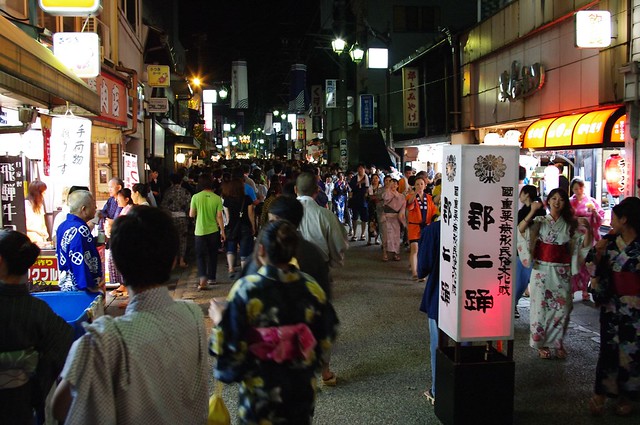 |
| Gujo odori (credit: tsuda/flickr) |
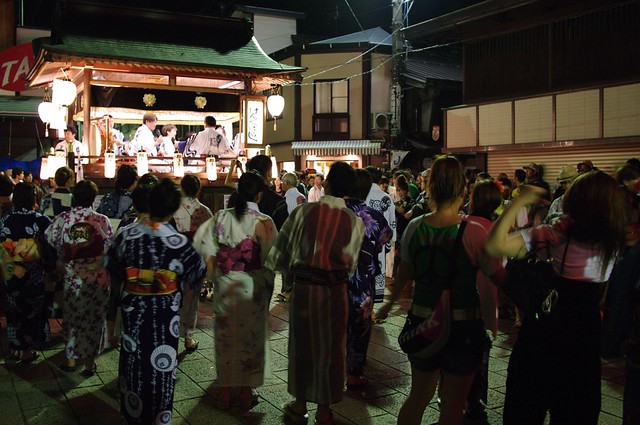 |
| Gujo odori (credit: tsuda/flickr) |
 |
| Gujo odori (credit: tsuda/flickr) |
All Night Dancing
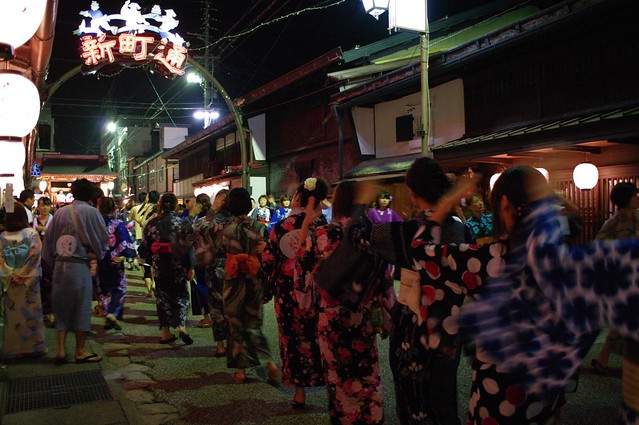 |
| Gujo odori all night (credit: tsuda/flickr) |
All Night Dancing
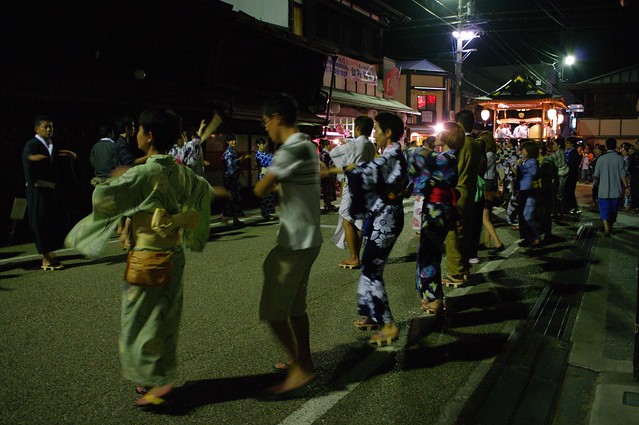 |
| Gujo odori all night (credit: tsuda/flickr) |
midnight stalls
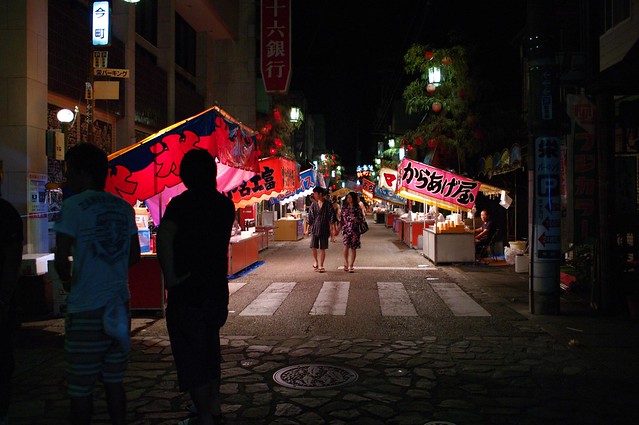 |
| Gujo odori all night (credit: tsuda/flickr) |
Nishimonai Bon Odori in Ugo-machi, Ogachi-gun, Akita Prefecture
The bon dance has been designated an Important Intangible Folk Cultural Property and takes place from 16 to 18 August every year.
Town Ugo Tourism&Products Association(Japanese version only):
http://ugo.main.jp/bonodori/index.html
The bon dance has been designated an Important Intangible Folk Cultural Property and takes place from 16 to 18 August every year.
Town Ugo Tourism&Products Association(Japanese version only):
http://ugo.main.jp/bonodori/index.html
What first strikes you about this dance performance are dancers wearing black, fabric full-face hoods with two eye holes. Other dancers also hide their faces with rush braided hats.
 |
| Nishimonai Bon Odori (credit:Chris Lewis/flickr) |
 |
| Nishimonai Bon Odori (credit:Chris Lewis/flickr) |
Dancers wear distinctive, traditional attire. They are patchworked kimono called hanui. The oldest attire has been passed down from the Edo period. It's not uncommon to see the attire over 100 years old.
 |
| Nishimonai Bon Odori (credit:Chris Lewis/flickr) |
 |
| Nishimonai Bon Odori (credit:Chris Lewis/flickr) |
 |
| Nishimonai Bon Odori (credit:Chris Lewis/flickr) |
There is no records showing the bon dance's derivation and history. It is said that Nishimonai Bon Odori is a mixture of the dances for harvest and for the dead.
According to legend, an ascetic monk built a branch shrine which enshrined Zao Gongen and got people dance to pray for abundant harvests at the shrine in the end of 13th century.
A lord of Yashima Castle took refuge in Nishimonai Castle whose lord was his wife's father, but troops tried to attack Nishimonai Castle. The Yashima Castle's lord committed suicide by sword to take responsibility for bringing trouble to his father-in-law in 1593. The Nishimonai Castle's lord set fire to his castle and escaped to Shonai region in 1600. One theory holds that some retainers of the Yashima Castle's lord started Bon dance to pray for the soul of the deceased lord. According to another thoery, some ex-retainers of the Nishimonai Castle's lord who remained as farmers in Nishimonai started Bon dance in a reminiscent mood.
Fujisawashuku Yugyounobon(Japanese version only):
http://www.fujisawa-cci.or.jp/yugyou2018%20bosyu/index.html
●another festivals other than the three main Bon odori
Yamaga Lantern Festival in Yamaga City, Kumamoto Prefecture
It is held on 15 and 16 August. Women in yukata(casual summer kimono) dance with Kanatoro(gold and silver paper lanterns) on their heads. Now most Kanatoro are LED paper lanterns.
Yamaga Toro(lantern) is made of washi paper and glue. It was designated as national traditional industrial arts in 2013. Kanatoro is popular, but Yamaga Toro has another design that has the shape of various buildings.
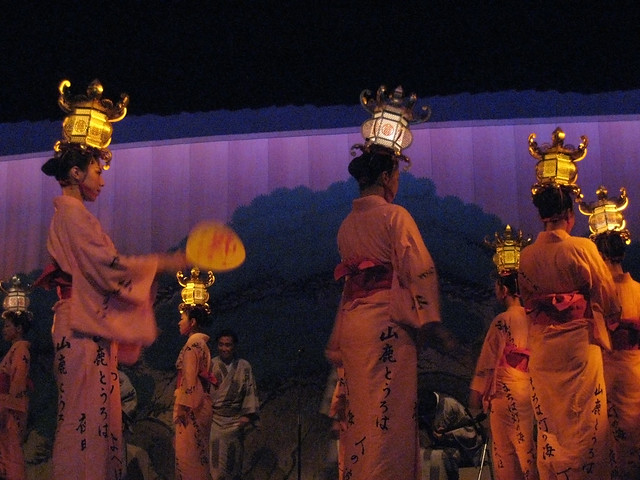 |
| Lantern Dancers in Yachiyosa theater (credit: JoshBerglund19/flickr) |
 |
| Lantern Dancers in Yachiyosa theater (credit: JoshBerglund19/flickr) |
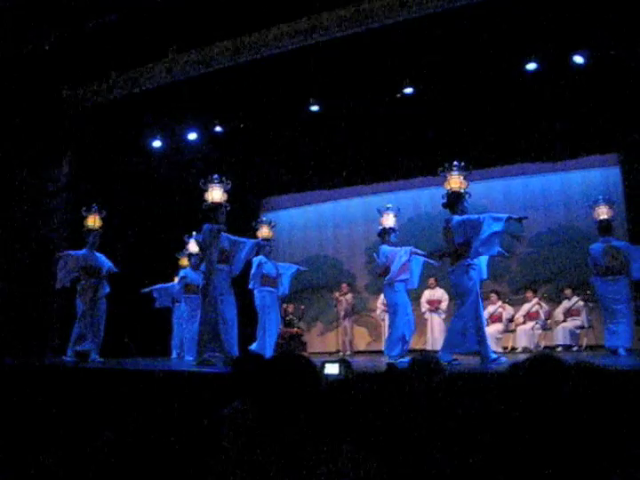 |
| Lantern Dancers in Yachiyosa theater (credit: JoshBerglund19/fllickr) |
Yamaga Toro dates back to the 12th century when Yamaga residents held up torches to light the way in a dense fog for Emperor Keiko and his party. They got to a temporary lodging for the emperor safely. The remains of the lodging(current Omiya Jinja Shrine) was dedicated to the emperor. The residents offered torches to the remains every year. In the Muromachi Period(ca.1336 - ca.1573), torches turned to paper lanterns.
It was in 1954 when women with lanterns on their head started to dance. Now 1,000 female dancers with lanterns on their head perform a dance for many tourists.
Yamaga Lantern Festival:
http://yamaga-tanbou.jp/about/toromatsuri/
Owara Kaze no Bon:
http://ichinen-fourseasonsinjapan.blogspot.com/2010/09/abnormally-hot-summer.html
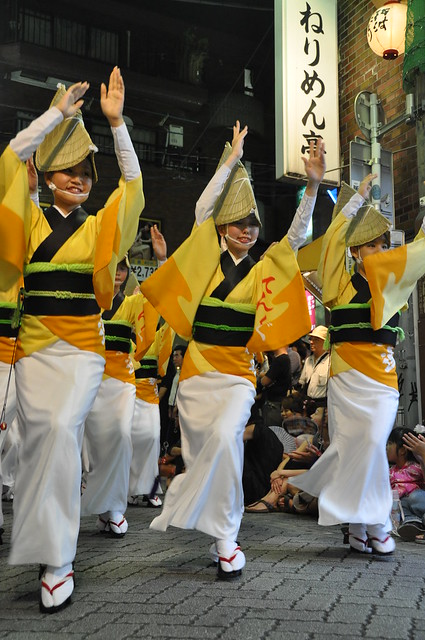
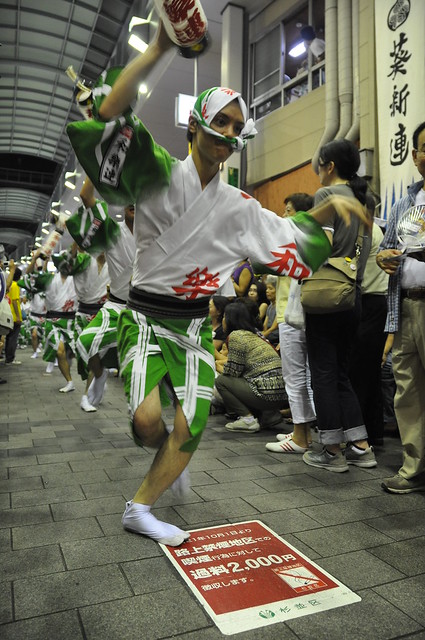
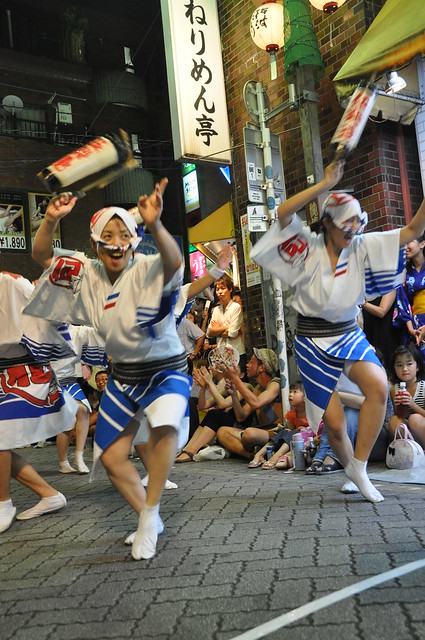

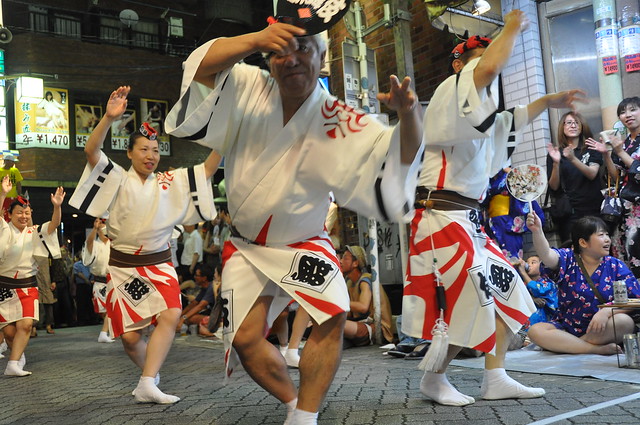
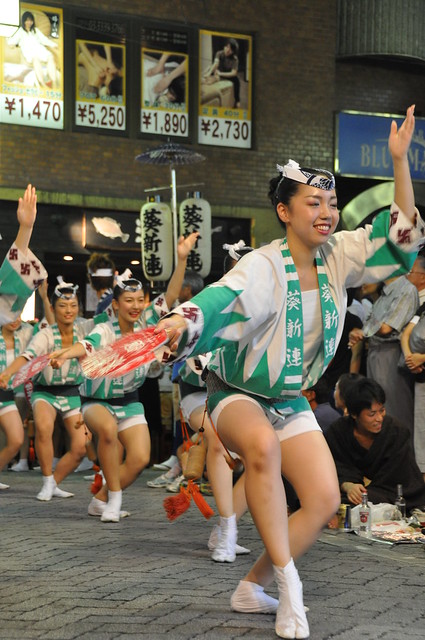
No comments:
Post a Comment